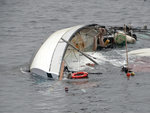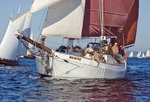They almost made it.
After three years circumnavigating North America in the 55-foot heavy yawl “Bertie,” Peter Bailey and Heidi Snyder were about 12 hours away from New York City, just off the Jersey Shore.
This item is available in full to subscribers.
We have recently launched a new and improved website. To continue reading, you will need to either log into your subscriber account, or purchase a new subscription.
If you had an active account on our previous website, then you have an account here. Simply reset your password to regain access to your account.
If you did not have an account on our previous website, but are a current print subscriber, click here to set up your website account.
Otherwise, click here to view your options for subscribing.
* Having trouble? Call our circulation department at 360-385-2900, or email our support.
Please log in to continue |
|


They almost made it.
After three years circumnavigating North America in the 55-foot heavy yawl “Bertie,” Peter Bailey and Heidi Snyder were about 12 hours away from New York City, just off the Jersey Shore.
“To avoid Cape Fear and Cape Hatteras, we were way out,” Bailey said. “It is a righteously nasty place to be caught in bad weather. It was the evening and I was asleep.”
To date, the trip had been smooth sailing. After leaving Port Townsend in 2016, the couple had traveled south along the Pacific Coast, crossed over through the Panama Canal, and was heading north to New England. Their last stopover was in Georgetown, South Carolina, where they checked upcoming weather conditions. All seemed well for the trip, Snyder said.
But, off the Jersey Shore, they began receiving reports of tornadic activity and they could see lightning strikes on the horizon, they said.
Just shy of 8 p.m. Eastern Standard Time on May 29, Snyder was finishing her watch on deck.
“There was some fog on the horizon,” she said. “There were no big choppy seas, no big winds, nothing. Just 15 knot winds from the east.”
Relaxed, Snyder let Bailey sleep about 10 extra minutes before waking him for his watch, she said.
“He was in the stern cabin and the whole sky turned white in front of me. I was like, ‘Holy shit! Peter, get up here!’”
Peter, just emerging from his bunk, was in a long-sleeved cotton shirt and his underwear, he said.
“I was in about the middle of the boat, and I heard her yelling.”
The wind had switched 180 degrees in a matter of seconds and had increased to 50 or 60 knots, Bailey estimated.
“It blew the boat down. The sails were flat on the water, 90 degrees as I came out.”
Bailey was standing on the bulwark, perpendicular to the deck.
He had just emerged, so the small doors to the cabin were open, and seawater began rushing in.
As the wave, a white squall, swept over the boat, Snyder thought to herself, “There is no coming back from this. This is it.”
The last thing Snyder remembers is Bailey calling for help to close the doors. But there was simply not enough time to act.
“As soon as the water got in, the boat went turtle and the deck was on top of me,” Bailey said. “I was completely underwater. Everything was crashing around. It was chaos.”
The two found themselves underneath the upside down boat. They were able to free themselves and emerge from the water, taking deep breaths as they broke the surface.
“I got out from under going aft and climbed up the transom and got up on the bottom of the boat,” Bailey said. “It wasn’t particularly rough and the wind seemed to have gone down, back to 15 knots. It was a microburst, a huge blast.”
While under the water, Snyder kicked off her boots, transitioning into survival mode.
“I knew we were going to get saved,” she said. “I didn’t think we were going to die. I was very much in the present moment just doing what was next.”
Calling for help
Now sitting atop their capsized boat, the two needed to signal for help. Following protocol, the Bertie was equipped with an emergency position-indicating radiobeacon, which when activated sends out a distress signal via satellite picked up by emergency rescue services.
“It was secured outside the pilot house so we could get at it in case of emergency,” Bailey said. “But the boat was upside down and the pilot house was six feet under water surrounded by crashing debris, broken things and entangled ropes sloshing back and forth.”
Both Bailey and Snyder made repeated attempts to dive for the device, but couldn’t reach it, they said.
Eventually, the buoyancy of the 46-foot-long wooden mast was enough to turn Bertie on her side, placing the beacon within reach, Bailey said.
“I could see it underwater. I got it out of its little case in total blackness. I couldn’t read the directions. I am sitting there in the dark fiddling with the switch and click, it goes on. The strobe starts going off.”
At this point, the only thing the couple could do was hold on and wait as they bobbed up and down in the waves.
Because the sunset was at about 8:30 p.m. that day, and since the moon would not rise until about 3:30 a.m., the two were in near-total darkness. The only source of light was the flashing strobe from the emergency beacon, and light refracting from the clouds, they said.
Bailey, minimally dressed, was beginning to experience the effects of hypothermia. To help, Snyder had cut loose a paddle board which had been lain atop Bertie, and the two sat huddled together on it.
“I was getting so cold I was losing brain function,” Bailey said. “I could feel myself shutting down. I was not able to make good decisions. I was getting lethargic. I was snuggling in her neck. It was the only warm place in the universe.”
“Peter, I sort of scooped up into my body,” Snyder said.
The rescue
At about 11:30 p.m., the two spotted a helicopter on the horizon, inbound from the mainland.
“I was in the Coast Guard for four years and participated in a lot of rescues back in the 1960s,” Bailey said. “I knew the guys were doing their job.”
A rescue swimmer jumped into the water, and swam to the Bertie, asking Bailey and Snyder if they were injured.
Heidi was rescued first; placed in a basket which was hoisted up to the helicopter.
Then it was Bailey’s turn.
“They lowered the wire back down without the basket and then he swam back over to the boat and asked me if I was a strong swimmer,” Bailey said.
Violently shaking due to hypothermia, Bailey replied he was not.
“He towed me like a lifeguard does. He buckled me into a harness he was wearing, which makes it a two man lift. He hooks in and zips us up to the helicopter. They had the heaters on and gave us some blankets. It was very nice.”
It is currently unknown if the Bertie is still floating somewhere in the Atlantic, of if she sank to the bottom, Bailey said.
The loss of Bertie is felt especially by Bailey, who helped build her. She was launched in 1984 in California, he said.
Bailey had eventually moved to the Pacific Northwest, where he and his boat became well known fixtures, said Brooks Townes of Port Townsend who witnessed the construction.
“He relocated with the boat to Port Townsend—a natural progression for a number of our wooden boat builders. The couple are well known on PT’s working waterfront, the Bertie a prominent resident for years on the Boat Haven’s linear dock.”
Peter also taught at the Northwest School of Wooden Boatbuilding, Townes said.
A clean break
In addition to Bertie, everything the couple owned was lost in the wreck including tools, phones, computers, passports, important documents, artwork, photography equipment, photos, travel mementos and clothing.
“There was grief at the loss but freedom at the thought of starting over,” Snyder said. “It was such a clean break. With flood victims and fire victims you have to continually go back to the site and look through the stuff.”
Snyder calls the incident, the “ultimate reset of your life.”
“All your stuff is gone in a flash,” she said. “You have a connection to it and have feelings of loss, but at the same time we’re a culture that is owned by our stuff. We buy so much unnecessary stuff.”
Without the items, Snyder said she feels lighter.
“Now we have this opportunity to start over. We are on a different coast. We have a different boat we are about to get.”
Following the incident, Bailey and Snyder set up a Gofundme page to help them start over. To date, they have raised about $21,000 of a goal of $50,000.
“The response to our crisis was overwhelming, and the support made it possible to have a dignified and swift transition from disaster mode to a sense of normalcy,” Snyder said. “We will forever hold these kindnesses in our hearts and pay it forward to the best of our abilities whenever possible.”
The money they have raised is helping to purchase a new 36-foot sailboat, the Moccasin, from Cape George Marine Works in Port Townsend.
“They have been manufacturing sailboats from 31 to about 45 feet since the 1970s,” Bailey said. “What they do is build very heavy fiberglass hulls and put a wooden deck and interior in it.”
The hulls are of one-piece hand-laid moldings of fiberglass utilizing vinyl ester-based resins, according to the company’s website. The deck beams and carlins are of laminated Port Orford Cedar, a premier species for boat building with excellent resistance to decay. The deck and cabin structure is heavily sheathed with fiberglass mat and roving, combining the low-maintenance exterior of fiberglass with the interior beauty of a wooden vessel.
Less maintenance will be welcome, Snyder said.
“Maintaining a wooden boat is an arduous labor of love.”
The new sailboat should also be less likely to capsize than Bertie, Bailey said.
“She had a very wide and flat design, old fashioned. Yet it is capsizeable if you push them hard enough, and we found that limit.”
The couple recently bought their new boat, Mocassin. They are currently island hopping and making their way to Port Townsend for the Wooden Boat Festival.
Snyder said although she has visions of the wreck, she still feels safer on the high seas than she ever will on a highway.
Editor’s note: News of the wreck of the Bertie is several months old, but we have timed publication of this article to coincide with the 43rd Wooden Boat Festival, so that the arriving community of wooden boat builders and fans can circulate this and help float Peter Bailey and Heidi Snyder’s new home at sea by joining the 250 people who have already donated to help them at https://www.gofundme.com/f/1niftccdio